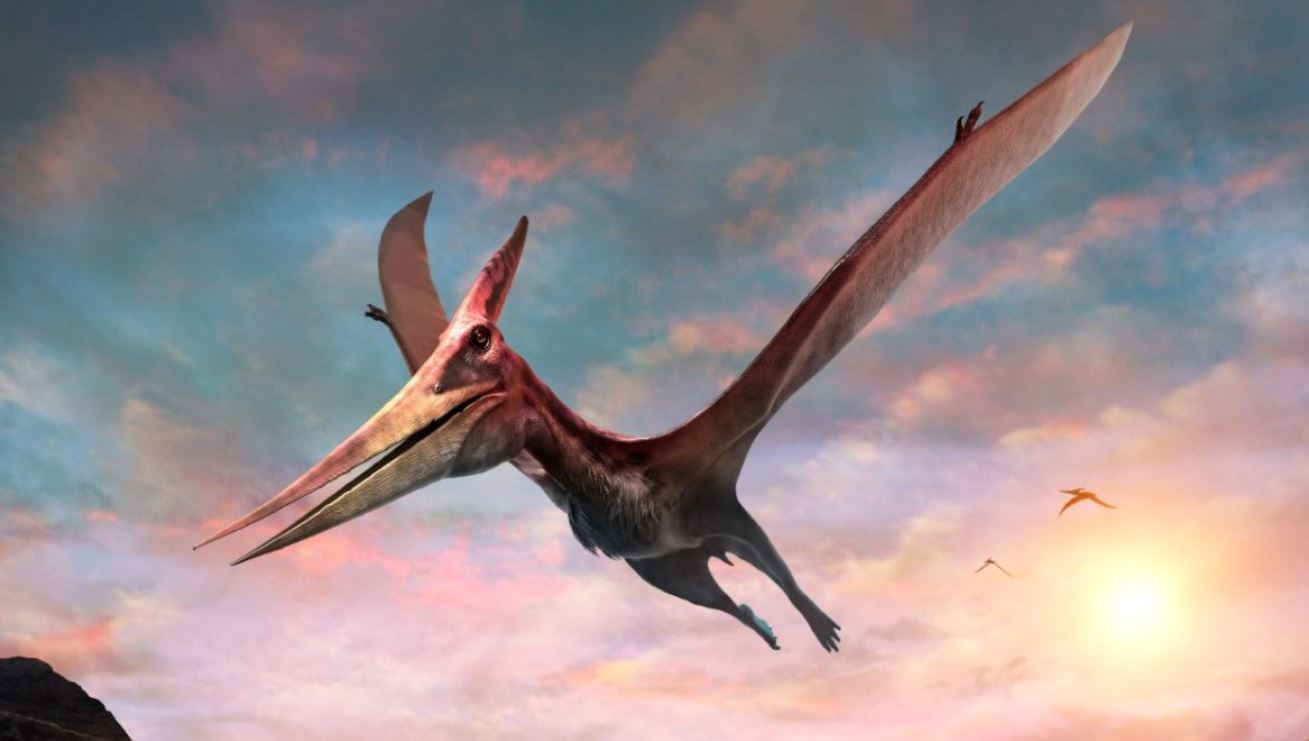Pterosaur trivia, images, and extensive knowledge.
During the Mesozoic Era, there existed a unique group of creatures known as pterosaurs, soaring above the dinosaurs. These remarkable prehistoric reptiles with wings were the pioneers of vertebrate flight.
Prepare to become a pterosaur aficionado as you delve into the evolution of these fascinating creatures, explore various types of pterosaurs, and uncover a wealth of information.
Unraveling the Pterosaur Enigma
Pterosaurs were extinct flying reptiles that coexisted with dinosaurs during the Mesozoic Era. They emerged approximately 220 million years ago in the Late Triassic and vanished during the Cretaceous-Paleogene Extinction Event, which took place 66 million years ago.
Pterosaurs held the distinction of being the first vertebrates capable of powered flight. The largest specimens, such as Quetzalcoatlus and Arambourgiania, claim the title of the largest flying creatures to have ever existed.
However, it is important to note that pterosaurs were not the initial aviators of the animal kingdom. That honor belongs to insects, which had been airborne for over a hundred million years before the emergence of pterosaurs.
Pterosaurs possessed wings composed of muscular and membranous structures. These wings were attached to the elongated fourth finger of their forelimbs. Special joints in this finger allowed the wings to be folded when not in use.
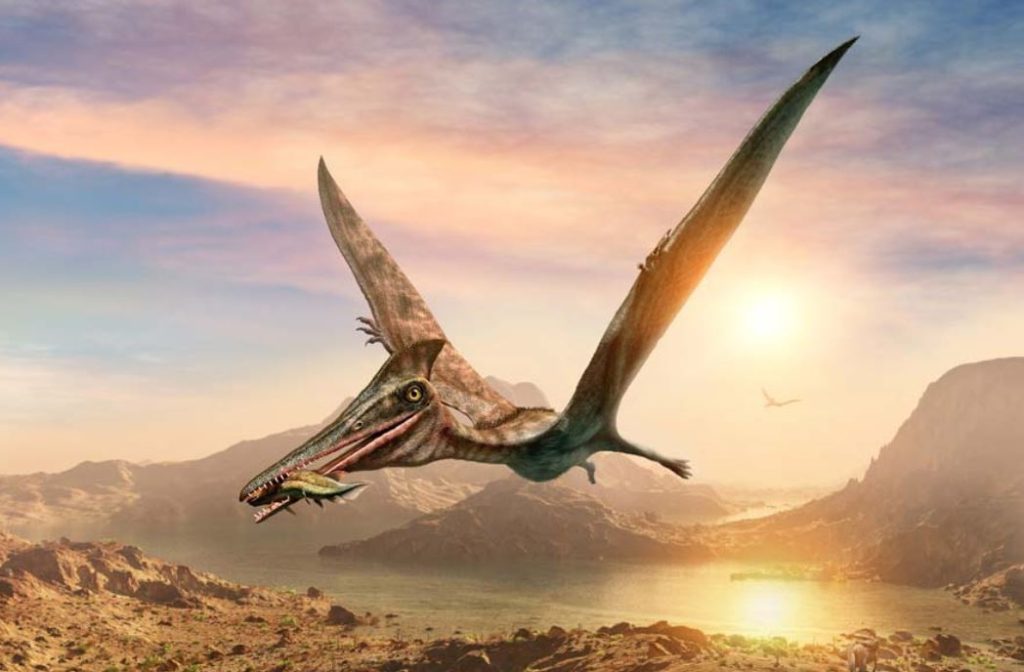
While many pterosaurs thrived in coastal habitats and specialized in consuming fish, they also diversified into scavengers, carnivores, insect eaters, and even omnivores.
Pterosaur vs. Pterodactyl
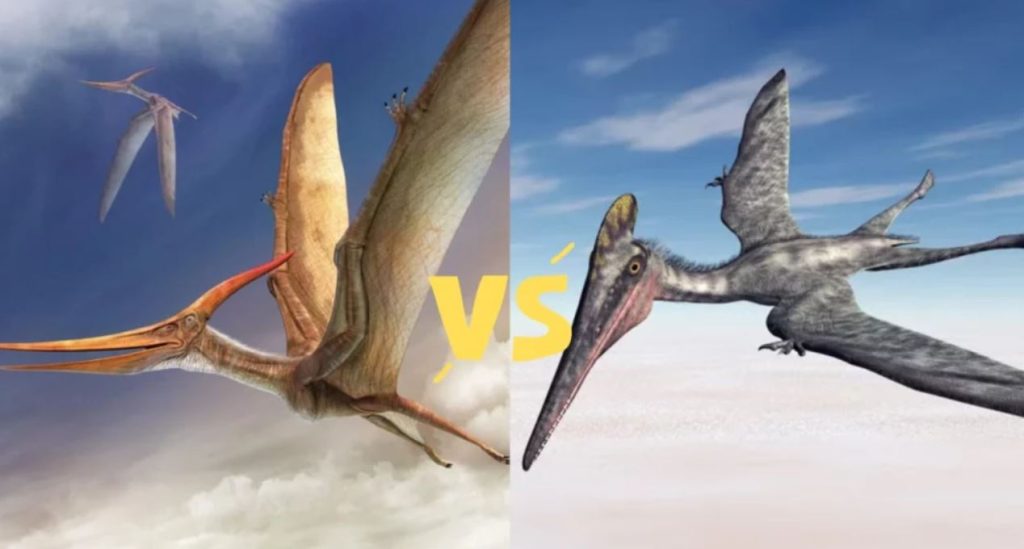
Pterodactylus, discovered in 1784 in Germany’s Solnhofen limestone, was the first pterosaur to be identified accurately as a flying reptile. Due to its widespread recognition, the term “Pterodactyl” is occasionally misused to refer to any pterosaur, which is incorrect.
Various Pterosaur Types
Pterosaurs belonged to the order Pterosauria, which can be further divided into two main suborders: Rhamphorhynchoidea and Pterodactyloidea.
1. Rhamphorhynchoidea – The Early Pterosaurs

Rhamphorhynchoidea encompasses early pterosaurs such as Eudimorphodon, Dimorphodon, and Rhamphorhynchus. These pterosaurs featured long tails and toothed jaws. Most of them lacked bony crests, although some possessed crests composed of soft tissue. Several early pterosaurs had diamond-shaped flaps at the end of their tails, potentially aiding in flight maneuvering.
The majority of rhamphorhynchoids became extinct by the end of the Jurassic Period, although some may have survived until the Late Cretaceous.
2. Pterodactyloidea – Advanced Pterosaurs
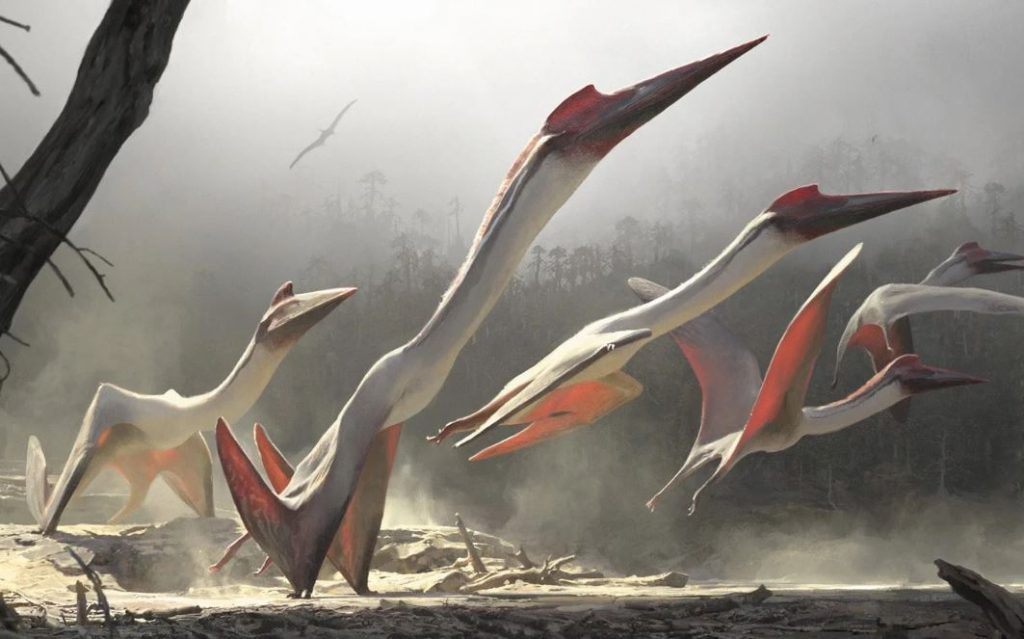
Pterodactyloidea includes pterosaurs like Pterodactylus, Pteranodon, and Quetzalcoatlus.
These advanced pterosaurs emerged during the Late Jurassic, evolving from earlier pterosaurs. They possessed shorter tails, and many featured bony crests on their heads. By the end of the Cretaceous Period, most pterodactyloids had lost their teeth.
Pterodactyloids, like non-avian dinosaurs, met their demise during the Cretaceous-Paleogene Extinction Event.
How Many Pterosaurs Existed?
Currently, approximately 250 different pterosaur species have been identified.
Notable Pterosaur Characteristics

1. Hollow Bones: Pterosaurs possessed unique adaptations for flight. Their bones were hollow, reducing weight while providing the necessary strength for efficient wing flapping. Air sacs within the bones and wings facilitated the optimal transfer of oxygen to the hard-working wing muscles.
2. Excellent Vision & Large Brains: Pterosaurs boasted large eye sockets, indicating excellent visual capabilities—a crucial trait for flying creatures. Furthermore, they possessed relatively large brains compared to other reptiles, enabling them to navigate the complexities of flight.
3. Beak-like Mouth Parts: Pterosaurs sported beak-like structures in their mouths, reflecting their diverse ecological roles. Different types of pterosaurs exhibited specific adaptations in their skulls and teeth, suited for varied diets. Some had tweezers-shaped bills and flat teeth for consuming shellfish, while others had interlocking teeth for catching fish or thin, comb-like teeth for filtering food from water. The most advanced pterosaurs lacked teeth altogether.
4. Pterosaur Wings: Pterosaurs’ wings were composed of skin, muscle, and blood vessels, reinforced by actinofibrils—fibers that provided strength and flexibility. These wings extended between the elongated fourth finger and hind legs, possibly attaching to the ankle. Some pterosaurs also featured a smaller membrane extending from the fourth finger to the shoulder, and a wing connecting the hind legs. In later pterosaurs, these wing structures were modified to enhance ground movement.
Feathered Enigma: Did Pterosaurs Have Feathers?
Unlike true feathers, pterosaurs did not possess them. However, many pterosaurs exhibited fur-like filaments known as pycnofibers covering their heads and bodies. These pycnofibers were also found in numerous dinosaur species and may have served as the precursors to true feathers.
Cold-Blooded or Warm-Blooded?
The presence of pycnofibers has led paleontologists to speculate that pterosaurs might have been endothermic or warm-blooded. Pycnofibers potentially played a role in temperature regulation, preventing heat loss. Endothermic animals have the ability to regulate their internal body temperature without relying on external conditions, such as basking in the sun.
Walking on Land
Pterosaurs had a unique joint mechanism in their elongated wing fingers, allowing them to fold their wings when not in flight. On the ground, they walked on all fours. Analysis of early pterosaur skeletons suggests they were adept climbers, more suited for vertical surfaces like tree trunks or cliffs than terrestrial locomotion. The pterosaurs’ membranous wings posed challenges for running, potentially contributing to birds’ eventual dominance over pterosaurs in various ecological niches.
I. Size Matters: How Large Were Pterosaurs?
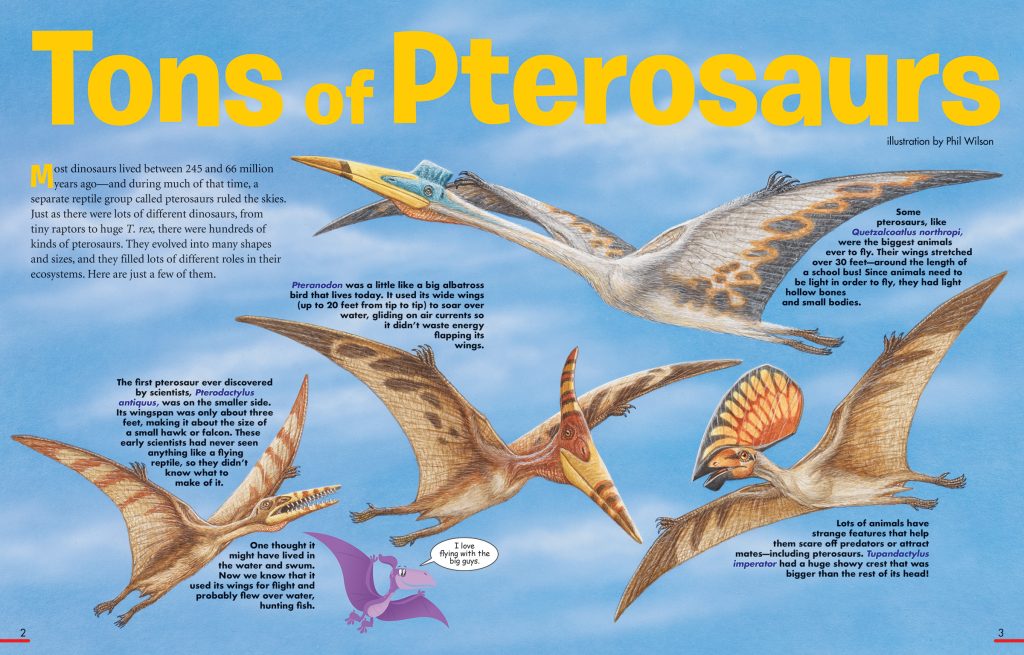
Pterosaurs exhibited a wide range of sizes. The smallest genera were comparable to crows in size, while the largest species surpassed small planes and even exceeded the height of giraffes.
1. The Smallest Pterosaur: Nemicolopterus, with a wingspan of approximately 25 centimeters (10 inches), holds the title of one of the smallest known pterosaurs. However, since only a juvenile specimen has been discovered, its adult size remains uncertain.
2. The Largest Pterosaur: Quetzalcoatlus takes the crown as the largest known pterosaur. This North American species from the Late Cretaceous boasted a colossal wingspan of around 11 meters (36 feet). With its neck extended, it stood over 3 meters (9.8 feet) tall.
Journeying through Pterosaur Evolution
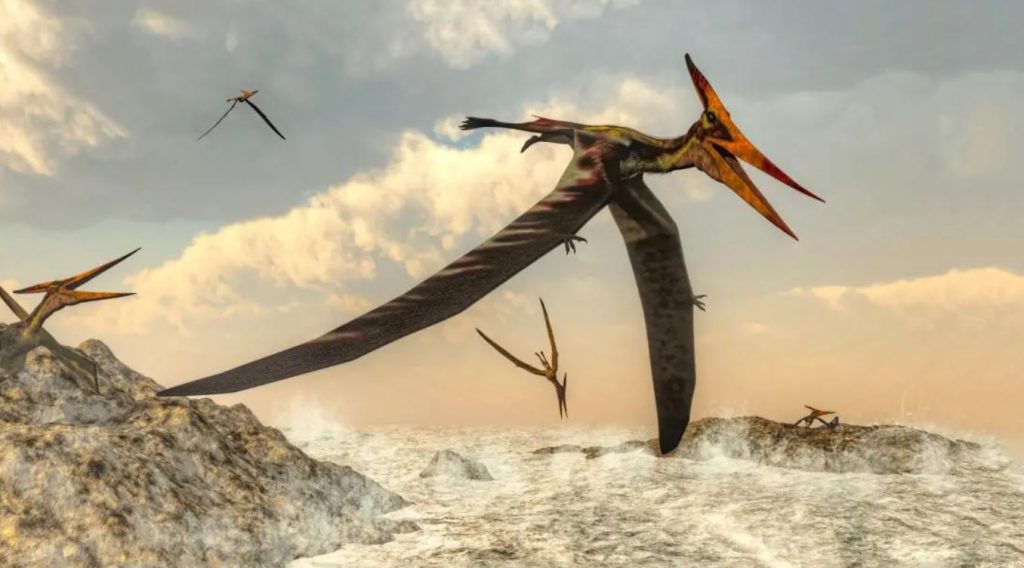
Pterosaurs emerged approximately 220 million years ago during the Late Triassic. Like dinosaurs, they belonged to the group of archosaurs. Archosaurs appeared early in the Triassic Period and later split into two main groups: Avemetatarsalia and Pseudosuchia.
Both pterosaurs and dinosaurs were avemetatarsalians, while pseudosuchians were the ancestors of present-day crocodilians. During the Triassic Period, pseudosuchians were the dominant terrestrial animals before the rise of dinosaurs.
Pterosaurs and dinosaurs shared a common ancestor, likely a terrestrial avemetatarsalian similar to Lagerpeton, a reptile from the Late Triassic. Eventually, Avemetatarsalia diverged into two primary branches: dinosaurs and pterosaurs.
Pterosaurs likely evolved from reptiles such as Sharovipteryx, a gliding reptile found in Central Asia during the Middle Triassic, or Scleromochlus, a small Triassic reptile that moved by hopping or jumping. Fossils of Scleromochlus were discovered in Scotland.
Unveiling the Earliest Pterosaur
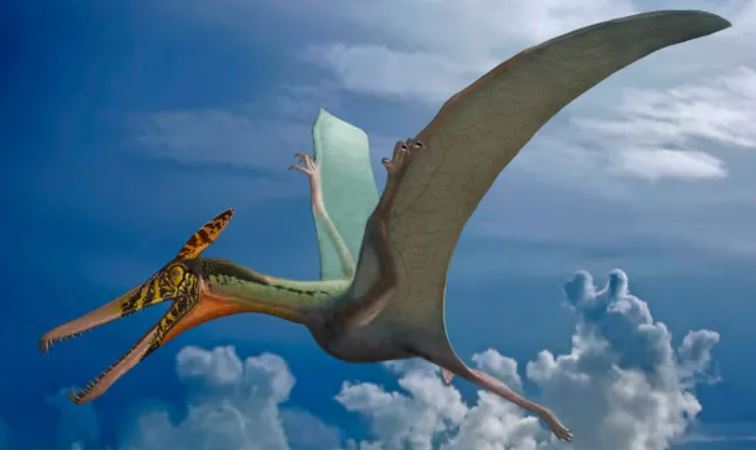
One of the earliest-known pterosaurs is Eudimorphodon, found in Italy and Greenland. This early pterosaur had a wingspan of around 1 meter (3 feet 3 inches) and possessed approximately 110 teeth—some pointed for gripping, others suited for grinding. Paleontologists believe it had a diet primarily composed of fish.
Fun Facts About Pterosaurs
1. Dietary Diversity: Pterosaurs were not solely coastal, fish-eating creatures. They inhabited various environments and showcased a wide range of feeding habits. Some were insectivores, others scavengers, some hunted while in flight, and a few may have even pursued prey on the ground.
2. Global Distribution: Pterosaur fossils have been discovered on all continents, including Australia and Antarctica, indicating their widespread presence during the Mesozoic Era.
3. Pterosaurs vs. Dinosaurs: Pterosaurs are not dinosaurs. Although they shared a common ancestor within the Avemetatarsalia reptile group, pterosaurs and dinosaurs diverged during the Late Triassic.
4. Pterosaurs and Birds: Pterosaurs are not birds, but they share a closer evolutionary relationship with birds than any living creature. Birds descended from dinosaurs, which split from the pterosaur lineage during the Triassic Period. The closest living relatives of birds are crocodilians, whose ancestors branched off from the dinosaur lineage before the divergence of dinosaurs and pterosaurs.
5. Birds and Pterosaurs: Birds did not descend from pterosaurs. Pterosaurs became extinct at the end of the Cretaceous Period, leaving no direct descendants. Birds developed their flight capabilities independently of pterosaurs and coexisted with them for a significant period during the Cretaceous. Birds are considered by many scientists as living dinosaurs today.
6. Pterosaur Lifespan: Pterosaurs emerged around 220 million years ago in the Late Triassic and persisted until the end of the Cretaceous Period. They met their demise during the Cretaceous-Paleogene Extinction Event, which occurred 66 million years ago, marking the end of the Mesozoic Era, the “Age of Reptiles.”
